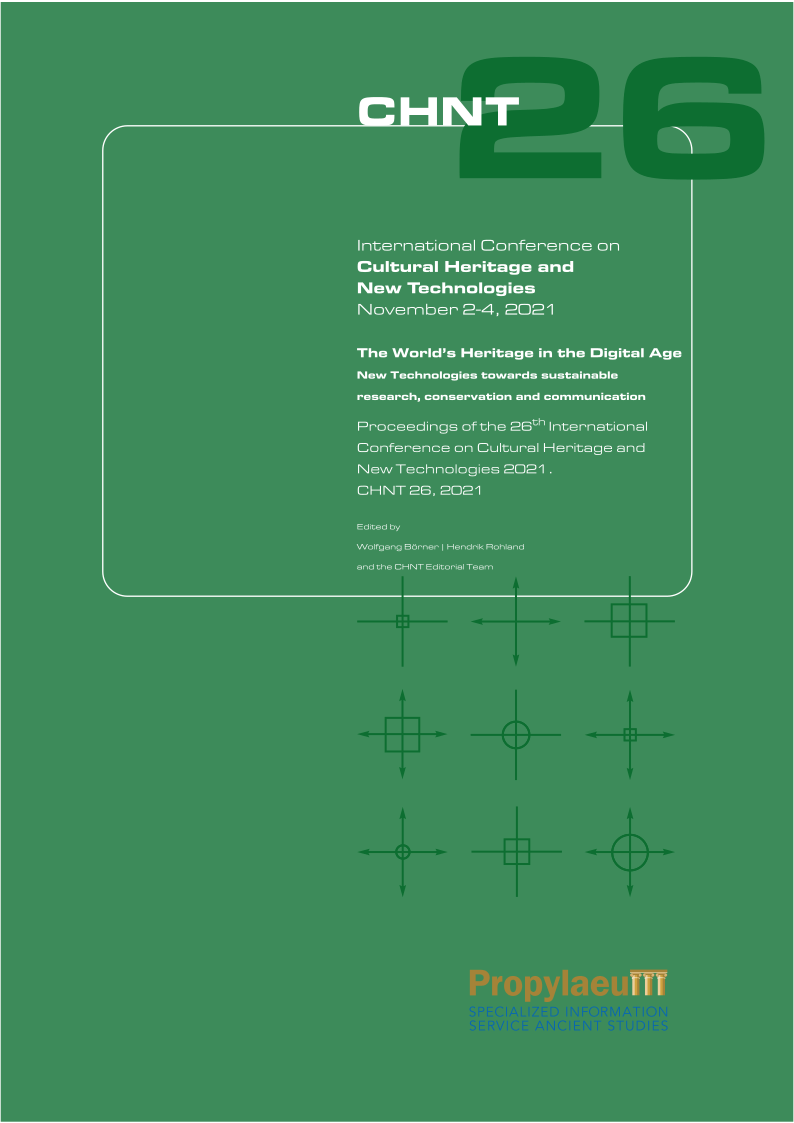Rapid and Reproducible Reconstruction of Ancient Architecture by Procedural Generation
Reconstructing the “Pavilion of the Rise of the Yuan Dynasty” in Karakorum, Mongolia
Keywords:
3D-reconstruction, reproducibility, procedural generation, Karakorum, MongoliaAbstract
This paper on Rapid and Reproducible Reconstruction of Ancient Architecture by Procedural Generation is about the reconstruction of the "Great Hall" of Karakorum as a 3D model. Since the “Great Hall” is an almost completely destroyed building, a possible reconstruction turns out to be quite difficult. The aim was therefore to develop a method with which existing research and theories as well as connections to other architectural styles can be incorporated into the reconstruction. Accordingly, many different variants come into question for a possible reconstruction. Therefore, it is important that hypotheses are not tested on the basis of a single reconstruction, but that it is possible to test several different hypotheses in a short time. Such a method can be created with the help of a procedural generation. In order to implement possible hypotheses as a 3D model with this method, it is important that the generation of the 3D model can be influenced with the help of changeable parameters. In the following the connections to the Chinese architecture are explained, as well as related works and theories are taken up, which pursued similar approaches and goals. Furthermore, the procedure of reconstruction is explained, and the method of procedural generation is illustrated by the creation of the so-called Puzuo system. Finally, a possible reconstruction of the "Great Hall" is presented, as well as the Blender panel created in the course of the work to determine the individual parameters.
References
Charleux, I. (2010). ‘Qing Imperial Mandalic Architecture for Gelugpa Pontiffs Between Beijing, Inner Mongolia and Amdo’, in E. Lehner, A. Harrer, & H. Sint, (eds.) Along the Great Wall: Architecture and Identity in China and Mongolia. Wien: IVEA-ICRA, pp. 107–118.
Cleaves, F. (1952). ‘The Sino-Mongolian inscription of 1346: In memoriam Wladyslai Kotwicz’, Harvard Journal of Asiatic Studies, 15, pp. 1–123.
Brooks, R.J. And Tobias, A.M. (1996). ‘Choosing the best model: Level of detail, complexity, and model perfor-mance’, Mathematical and Computer Modelling, 24(4), pp. 1–14.
Franken, C. (2015). Die ‘Große Halle’ von Karakorum: Zur Archäologischen Untersuchung des ersten buddhisti-schen Tempels der alten mongolischen Hauptstadt. Bonn.
Guo, Q. (1995). The Structure of Chinese Timber Architecture. Göteborg.
Hüttel, H.-G. (2016). ‘Die Stadt als Herrschaftssymol: Beispiel Karakorum’, in Walravens, H. and Müller, C. (eds.) Status und Symbol. Neuerwerbungen der Ostasienabteilung. Berlin, pp. 63–82.
Hüttel, H.-G. (2009) ‘Royal Palace or Buddhist Temple? On Search for the Karakorum Palace’, in Bemmann, J., Parzinger, H., Pohl, E., and Tseveendorzh, D. (eds.) Current Archaeological Research in Mongolia. Bonn (Bonn Contributions to Asian Archaeology), pp. 535–548.
Киселев, С.В. and Евтюхова, Л.А. (1965). ‘Дворец Кара-Корума’, in Киселев, С.В., Евтюхова, Л.А., Кысласов, Л.Р., Мерперт, Н.Я., and Левашова, В.П. (eds.) Древнемонгольские города. Москва, pp. 138–166.
Kolenda, J and Markiewicz, M. (2017). ‘A medieval bishop's palace in milicz: 3d reconstruction as a method of a research hypotheses presentation’, Studies in Digital Heritage, 1(2), pp. 428–443,
Liu, H., Wang, Q., Hua, W., Zhou, D. and Bao, H. (2005). ‘Building chinese ancient architectures in seconds’, in Sunderam, V.S., van Albada, G.D., Sloot, P., and Dongarra, J.J. (eds.) Computational science - ICCS 2005, Volume 3515 of Lecture Notes in Computer Science, pp. 248–255. Springer: Berlin.
Shaker, N., Togelius, J. and Nelson, M.-J. (2016). Procedural content generation in games. Cham:Springer.
Freiknecht, J. and Effelsberg, W. (2017). ‘A survey on the procedural generation of virtual worlds’, Multimodal Technologies and Interaction, 1(4).
Martin, J. (2005). ‘Algorithmic beauty of buildings methods for procedural building generation’, Computer Science Honors Theses, 4. Available at: http://digitalcommons.trinity.edu/compsci_honors/4.
Verdani, G., Charalambous, A. and Braghiroli, A. (2020). ‘Generative modeling from architecture to archaeology: Po-tentials and challenges in the present and future scenarios’, Proceedings of the 25th conference on Cultural Her-itage and New Technology 2020. [Abstract]. Available at: https://www.chnt.at/wp-content/uploads/Generative-modeling-from-Architecture-to-Archaeology.pdf.
Muller, P., Vereenooghe, T., Wonka, P., Paap, I. and Gool, L. v. (2006). ‘Procedural 3d reconstruction of puuc buildings in xkipch´e’, in Ioannides, M., Arnold, D., Niccolucci, F., and Mania, K. (eds.) VAST: International Symposium on Virtual Reality, Archaeology and Intelligent Cultural Heritage. The Eurographics Association, pp. 139-146.
Downloads
Published
Conference Proceedings Volume
Section
License
Copyright (c) 2025 Dominik Klenk, Hendrik Rohland, Marco Block-Berlitz, Christina Franken

This work is licensed under a Creative Commons Attribution-ShareAlike 4.0 International License.
The CHNT older Proceedings are licensed under the creative commons license CC BY-NC-ND 3.0.
From the issue 26 on, they will be licensed under the creative commons license CC-BY-SA 4.0


